-
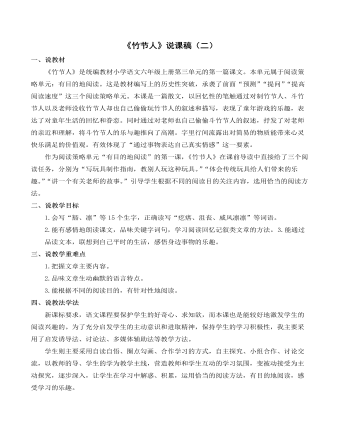
部编人教版六年级上册《竹节人》说课稿(二)
3.再读课文,划分段落结构。说说本文可以分为哪几个部分,简要概括各部分的主要内容。第一部分(1--2段):概述“我们”小时候喜欢玩自己做的竹节人。 第二部分(3--7段):写制作竹节人的过程。 第三部分(8--19段):主要写斗竹节人的过程与乐趣,表现了孩子们对竹节人游戏的喜爱。 第四部分(20--29段):主要写老师没收了竹节人,却也偷偷在玩竹节人的趣事。 尊重学生的初始阅读感受,引导学生有意识地根据课前导语部分的阅读任务进行有目的地阅读,在自主探究中发现阅读方法。接着小组交流:根据不同的阅读目的,是怎么阅读课文的。让学生交流、丰富自己的阅读方法,同时教师适时引导,让学生学会积累、运用恰当的阅读方法。在对阅读任务的把握上,感知课文内容,理清文章层次,这样学生对文章内容结构的划分就水到渠成了。
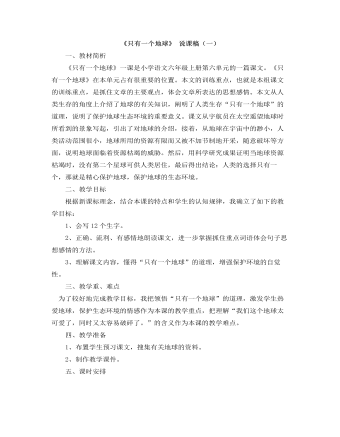
部编人教版六年级上册《只有一个地球》说课稿(一)
一、教材简析《只有一个地球》一课是小学语文六年级上册第六单元的一篇课文。《只有一个地球》在本单元占有很重要的位置。本文的训练重点,也就是本组课文的训练重点,是抓住文章的主要观点,体会文章所表达的思想感情。本文从人类生存的角度上介绍了地球的有关知识,阐明了人类生存“只有一个地球”的道理,说明了保护地球生态环境的重要意义。课文从宇航员在太空遥望地球时所看到的景象写起,引出了对地球的介绍,接着,从地球在宇宙中的渺小,人类活动范围很小,地球所用的资源有限而又被不加节制地开采,随意破坏等方面,说明地球面临着资源枯竭的威胁。然后,用科学研究成果证明当地球资源枯竭时,没有第二个星球可供人类居住,最后得出结论:人类的选择只有一个,那就是精心保护地球,保护地球的生态环境。
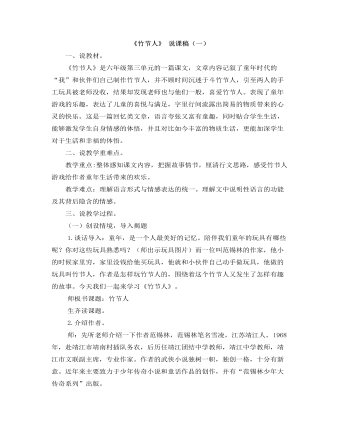
部编人教版六年级上册《竹节人》说课稿(一)
一、说教材。《竹节人》是六年级第三单元的一篇课文,文章内容记叙了童年时代的“我”和伙伴们自己制作竹节人,并不顾时间沉迷于斗竹节人,引至两人的手工玩具被老师没收,结果却发现老师也与他们一般,喜爱竹节人。表现了童年游戏的乐趣,表达了儿童的喜悦与满足,字里行间流露出简易的物质带来的心灵的快乐。这是一篇回忆类文章,语言夸张又富有童趣,同时贴合学生生活,能够激发学生自身情感的体悟,并且对比如今丰富的物质生活,更能加深学生对于生活和幸福的体悟。二、说教学重难点。教学重点:整体感知课文内容,把握故事情节,厘清行文思路,感受竹节人游戏给作者童年生活带来的欢乐。教学难点:理解语言形式与情感表达的统一。理解文中说明性语言的功能及其背后隐含的情感。
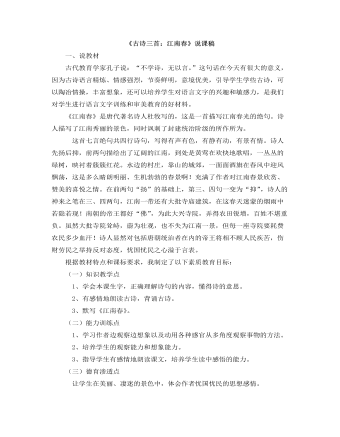
部编人教版六年级上册《古诗三首:江南春》 说课稿
在这样的情境下,学生情趣盎然,紧接着把学生带进新课,点击课件出示配景诗《江南春》,板书课题,齐读课题。接着检查学生的预习情况,每一上新课之前,我都要求学生进行预习,以此来培养学生独立自学能力和良好的学习习惯。然后让学生尝试说说,从题目中,你知道了什么?或你想知道什么?根据学生所说的和所提的,老师归纳总结出有价值的内容和问题,以便在学习古诗中深入渗透探究解决问题。(二)知诗人,介绍写作背景让学生把课前收集到的资料对诗人进行简介及介绍写作背景。这样不仅可以培养其收集处理信息的能力,又培养了口头表达能力及听说能力,又为理解古诗内容做好了准备,同时帮助其获取成功的体验,培养他们主动学习的品质。
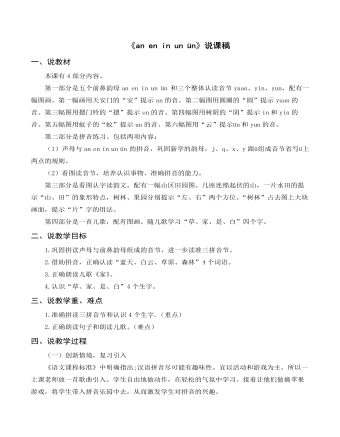
部编人教版一年级上册《an en in un ün》说课稿
二、说教学目标1.巩固拼读声母与前鼻韵母组成的音节,进一步读准三拼音节。??2.借助拼音,正确认读“蓝天、白云、草原、森林”4个词语。3.正确朗读儿歌《家》。4.认识“草、家、是、白”4个生字。三、说教学重、难点1.准确拼读三拼音节和认识4个生字.(重点)2.正确朗读句子和朗读儿歌。(难点)四、说教学过程(一)创新情境,复习引入《语文课程标准》中明确指出;汉语拼音尽可能有趣味性。宜以活动和游戏为主。所以一上课老师放一首歌曲引入。学生自由地做动作,在轻松的气氛中学习。接着让他们做摘苹果游戏,将学生带入拼音乐园中去,从而激发学生对拼音的兴趣。
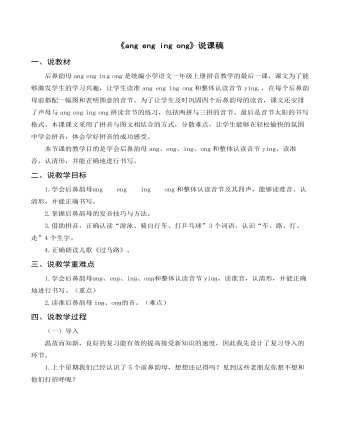
部编人教版一年级上册《ang eng ing ong》说课稿
后鼻韵母ang eng in g ong是统编小学语文一年级上册拼音教学的最后一课,课文为了能够激发学生的学习兴趣,让学生读准ang eng ing ong和整体认读音节ying.,在每个后鼻韵母前都配一幅图和表明图意的音节。为了让学生及时巩固四个后鼻韵母的读音,课文还安排了声母与ang eng ing ong拼读音节的练习,包括两拼与三拼的音节。最后是音节太阳的书写格式。本课课文采用了拼音与图文相结合的方式,分散难点,让学生能够在轻松愉快的氛围中学会拼音,体会学好拼音的成功感受。本节课的教学目的是学会后鼻韵母ang、eng、ing、ong和整体认读音节ying,读准音,认清形,并能正确地进行书写。二、说教学目标1.学会后鼻韵母ɑng??eng??ing??ong和整体认读音节及其四声,能够读准音、认清形,并能正确书写。?2.掌握后鼻韵母的发音技巧与方法。? 3.借助拼音,正确认读“游泳、骑自行车、打乒乓球”3个词语,认识“车、路、灯、走”4个生字。4.正确朗读儿歌《过马路》。三、说教学重难点1.学会后鼻韵母ɑnɡ、enɡ、inɡ、onɡ和整体认读音节yinɡ,读准音,认清形,并能正确地进行书写。(重点)2.读准后鼻韵母inɡ、onɡ的音。(难点)
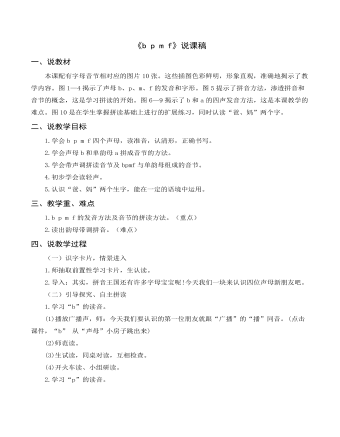
部编人教版一年级上册《b p m f》说课稿
一、说教材本课配有字母音节相对应的图片10张。这些插图色彩鲜明,形象直观,准确地揭示了教学内容。图1—4揭示了声母b、p、m、f的发音和字形。图5提示了拼音方法,渗透拼音和音节的概念,这是学习拼读的开始。图6—9揭示了b和a的四声发音方法,这是本课教学的难点。图10是在学生掌握拼读基础上进行的扩展练习,同时认读“爸、妈”两个字。二、说教学目标1.学会b p m f四个声母,读准音,认清形,正确书写。2.学会声母b和单韵母a拼成音节的方法。3.学会带声调拼读音节及bpmf与单韵母组成的音节。4.初步学会读轻声。5.认识“爸、妈”两个生字,能在一定的语境中运用。三、教学重、难点1.b p m f的发音方法及音节的拼读方法。(重点)2.读出韵母带调拼音。(难点)四、说教学过程(一)识字卡片,情景进入1.师抽取前置性学习卡片,生认读。2.导入:其实,拼音王国还有许多字母宝宝呢!今天我们一块来认识四位声母新朋友吧。? (二)引导探究、自主拼读1.学习“b”的读音。(1)播放广播声,师:今天我们要认识的第一位朋友就跟“广播”的“播”同音。(点击课件,“b” 从“声母”小房子跳出来)
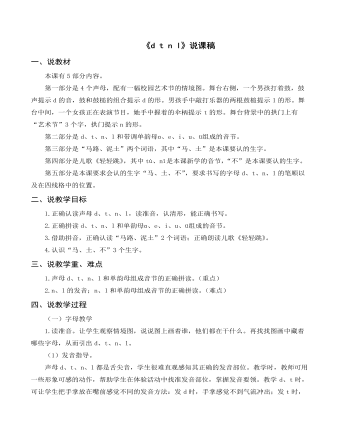
部编人教版一年级上册《d t n l》说课稿
(2)编儿歌练发音。教师要尽可能地利用与d、t、n、l发音相似的“的、特、呢、了”,编成儿歌,帮助学生较快地掌握发音要领。特别是声母n和l,初学时不少学生很容易混淆,可以编一些顺口溜,帮助学生加以区别。2.识记形。(1)观察字形。教师引导学生再次细致观察情境图,说一说d、t、n、l的形体各自有什么特点。告诉学生:d就像鼓和鼓槌组合在一起的样子,t就像女孩手中握着的伞柄,n就像舞台背景拱门的样子,l就像男孩手中的鼓槌。(2)形近字母辨析。d、t、n与前一课所学的b、f、m形体有相似之处,学生很容易混淆。可以让学生通过合作探究的学习方式,弄清它们之间的区别。在学生掌握读音后,出示d、t、n与b、f、m,让他们细细观察,反复比较,小组讨论得出它们的不同点:左下半圆是d,右下半圆是b,一根鱼竿是t,一根拐杖是f,一个门洞是n,两个门洞是m。教师还可以在课堂上展示雨伞实物:伞柄朝上就是t,伞柄朝下就是f。也可以启发学生编顺口溜,帮助记忆新学的字母,如,小鼓敲响ddd,伞柄朝上ttt,一个门洞nnn,一根小棍lll。
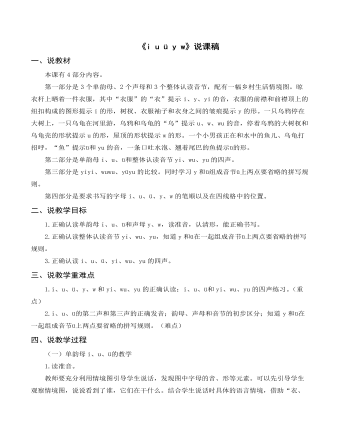
部编人教版一年级上册《i u ü y w》说课稿
三、说教学重难点1.i、u、ü、y、w和yi、wu、yu的正确认读;i、u、ü和yi、wu、yu的四声练习。(重点)2.i、u、ü的第二声和第三声的正确发音;韵母、声母和音节的初步区分;知道y和ü在一起组成音节ü上两点要省略的拼写规则。(难点)四、说教学过程(一)单韵母i、u、ü的教学1.读准音。教师要充分利用情境图引导学生说话,发现图中字母的音、形等元素。可以先引导学生观察情境图,说说看到了谁,它们在干什么。结合学生说话时具体的语言情境,借助“衣、乌、鱼”3个字的读音引出单韵母i、u、ü。(1)发音指导。告诉学生i、u、ü和ɑ、o、e都是单韵母,发音时一样,口型不能变动。通过反复示范,引导学生观察i、u、ü发音时的嘴型,掌握发音方法。同时,还可以利用第一单元学过的汉字“一”和“五”来帮助正音,让学生说说书上有哪些数量是“一、五”的景物,如一件衣服、一个男孩、一棵树、一只乌鸦、一条小河、一条鱼、一只乌龟;五个字母……将学习拼音与既有知识相结合,由旧知到新知,提高教学效率。
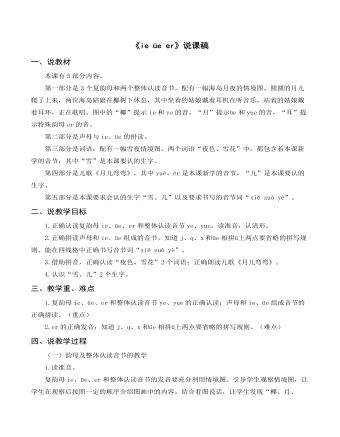
部编人教版一年级上册《ie üe er》说课稿
一、说教材本课有5部分内容。第一部分是3个复韵母和两个整体认读音节,配有一幅海岛月夜的情境图。圆圆的月儿爬了上来,两位海岛姑娘在椰树下休息,其中坐着的姑娘戴着耳机在听音乐,站着的姑娘戴着耳环,正在歌唱。图中的“椰”提示ie和ye的音,“月”提示üe和yue的音,“耳”提示特殊韵母er的音。第二部分是声母与ie、üe的拼读。第三部分是词语,配有一幅雪夜情境图。两个词语“夜色、雪花”中,都包含着本课新学的音节,其中“雪”是本课要认的生字。第四部分是儿歌《月儿弯弯》,其中yuè、ér是本课新学的音节,“儿”是本课要认的生字。第五部分是本课要求会认的生字“雪、儿”以及要求书写的音节词“xiě zuò yè”。二、说教学目标1.正确认读复韵母ie、üe、er和整体认读音节ye、yue,读准音,认清形。2.正确拼读声母和ie、üe组成的音节,知道j、q、x和üe相拼ü上两点要省略的拼写规则。能在四线格中正确书写音节词“xiě zuò yè”。3.借助拼音,正确认读“夜色、雪花”2个词语;正确朗读儿歌《月儿弯弯》。4.认识“雪、儿”2个生字。三、教学重、难点1.复韵母ie、üe、er和整体认读音节ye、yue的正确认读;声母和ie、üe组成音节的正确拼读。(重点)2.er的正确发音;知道j、q、x和üe相拼ü上两点要省略的拼写规则。
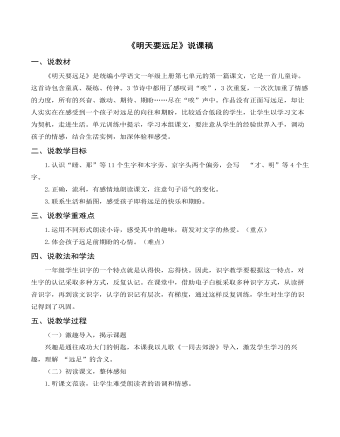
部编人教版一年级上册《明天要远足》说课稿
二、说教学目标1.认识“睡、那”等11个生字和木字旁、京字头两个偏旁,会写 “才、明”等4个生字。2.正确,流利,有感情地朗读课文,注意句子语气的变化。3.联系生活和插图,感受孩子即将远足的快乐和期盼。三、说教学重难点1.运用不同形式朗读小诗,感受其中的趣味,萌发对文字的热爱。(重点)?2.体会孩子远足前期盼的心情。(难点)四、说教法和学法一年级学生识字的一个特点就是认得快,忘得快。因此,识字教学要根据这一特点,对生字的认记采取多种方式,反复认记。在课堂中,借助电子白板采取多种识字方式,从读拼音识字,再到读文识字,认字的识记有层次,有梯度,通过这样反复训练,学生对生字的识记得到了巩固。
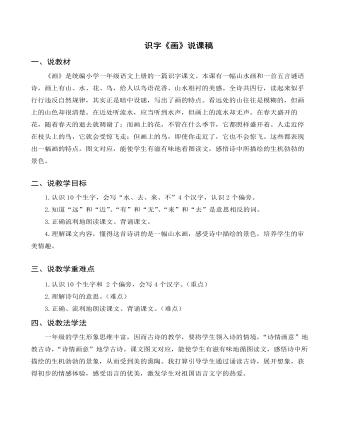
部编人教版一年级上册识字《画》说课稿
二、说教学目标1.认识10个生字,会写“水、去、来、不”4个汉字,认识2个偏旁。2.知道“远”和“近”、“有”和“无”、“来”和“去”是意思相反的词。3.正确流利地朗读课文、背诵课文。4.理解课文内容,懂得这首诗讲的是一幅山水画,感受诗中描绘的景色,培养学生的审美情趣。三、说教学重难点1.认识10个生字和 2个偏旁,会写4个汉字。(重点)2.理解诗句的意思。(难点)3.正确、流利地朗读课文、背诵课文。(难点)四、说教法学法一年级的学生形象思维丰富,因而古诗的教学,要将学生领入诗的情境,“诗情画意”地教古诗,“诗情画意”地学古诗。课文图文对应,能使学生有滋有味地循图读文,感悟诗中所描绘的生机勃勃的景象,从而受到美的熏陶。我打算引导学生通过诵读古诗,展开想象,获得初步的情感体验,感受语言的优美,激发学生对祖国语言文字的热爱。
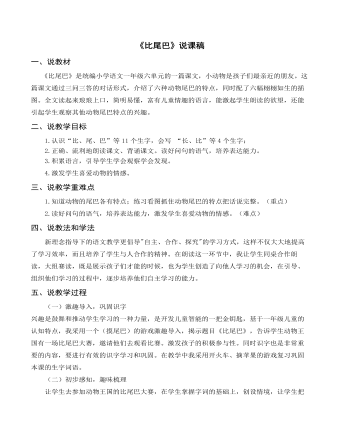
部编人教版一年级上册《比尾巴》说课稿
二、说教学目标1.认识“比、尾、巴”等11个生字,会写 “长、比”等4个生字;2.正确、流利地朗读课文、背诵课文。读好问句的语气,培养表达能力。3.积累语言,引导学生学会观察学会发现。4.激发学生喜爱动物的情感。三、说教学重难点1.知道动物的尾巴各有特点;练习看图抓住动物尾巴的特点把话说完整。(重点)?2.读好问句的语气,培养表达能力,激发学生喜爱动物的情感。(难点)四、说教法和学法新理念指导下的语文教学更倡导"自主、合作、探究"的学习方式,这样不仅大大地提高了学习效率,而且培养了学生与人合作的精神。在朗读这一环节中,我让学生同桌合作朗读,大组赛读,既是展示孩子们才能的时候,也为学生创造了向他人学习的机会,在引导、组织他们学习的过程中,逐步培养他们自主学习的能力。
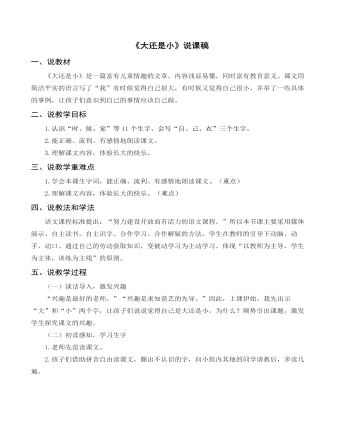
部编人教版一年级上册《大还是小》说课稿
二、说教学目标1.认识“时、候、觉”等11个生字,会写“自、己、衣”三个生字。2.能正确、流利、有感情地朗读课文。3.理解课文内容,体验长大的快乐。三、说教学重难点1.学会本课生字词,能正确、流利、有感情地朗读课文。(重点)?2.理解课文内容,体验长大的快乐。(难点)四、说教法和学法语文课程标准提出:“努力建设开放而有活力的语文课程。”所以本节课主要采用媒体演示、自主读书,自主识字、合作学习、合作解疑的方法。学生在教师的引导下动脑、动手、动口。通过自己的劳动获取知识,变被动学习为主动学习。体现“以教师为主导,学生为主体,训练为主线”的原则。
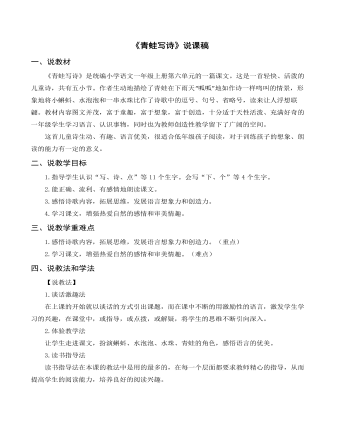
部编人教版一年级上册《青蛙写诗》说课稿
一、说教材《青蛙写诗》是统编小学语文一年级上册第六单元的一篇课文。这是一首轻快、活泼的儿童诗,共有五小节。作者生动地描绘了青蛙在下雨天“呱呱”地如作诗一样鸣叫的情景,形象地将小蝌蚪、水泡泡和一串水珠比作了诗歌中的逗号、句号、省略号,读来让人浮想联翩。教材内容图文并茂,富于童趣,富于想象,富于创造,十分适于天性活泼、充满好奇的一年级学生学习语言、认识事物,同时也为教师创造性教学留下了广阔的空间。 这首儿童诗生动、有趣、语言优美,很适合低年级孩子阅读,对于训练孩子的想象、朗读的能力有一定的意义。二、说教学目标1.指导学生认识“写、诗、点”等11个生字。会写“下、个”等4个生字。2.能正确、流利、有感情地朗读课文。3.感悟诗歌内容,拓展思维,发展语言想象力和创造力。4.学习课文,增强热爱自然的感情和审美情趣。三、说教学重难点1.感悟诗歌内容,拓展思维,发展语言想象力和创造力。(重点)?2.学习课文,增强热爱自然的感情和审美情趣。(难点)

部编人教版一年级上册识字《金木水火土》说课稿
二、说学情培养学生主动识字的愿望和独立识字的能力,是课程标准着力强调的基本理念。因此,本节课教师以自主交流、小组互为主体,努力将学生的识字愿望与课程标准理念相结合,引导学生“学习独立识字”,获得识字过程的丰富体验。三、说教学目标1.通过猜字谜、熟字比较等方法,能正确认读“一、二、三、四、五、上、下”等7个生字;通过教师指导,学生相互评价等能正确书写笔画“一 丨”和“一、二、三、上”;2.通过教师领读等多种方式能正确流利朗读课文,感受数字儿歌的特点。3.通过诵读儿歌的形式,引导学生掌握正确的书写和握笔姿势。四、说教学重、难点1.能正确流利朗读课文,感受数字儿歌的特点。(重点)2.通过教师指导,学生相互评价等能正确书写笔画“一 丨”和“一、二、三、上”。(难点)
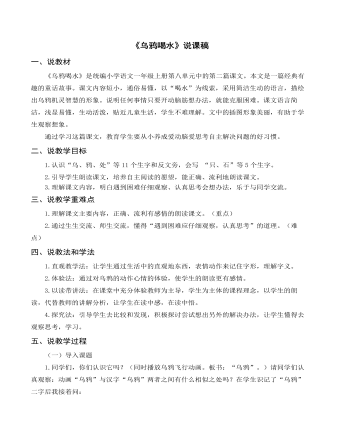
部编人教版一年级上册《乌鸦喝水》说课稿
二、说教学目标1.认识“乌、鸦、处”等11个生字和反文旁,会写 “只、石”等5个生字。2.引导学生朗读课文,培养自主阅读的愿望,能正确、流利地朗读课文。3.理解课文内容,明白遇到困难仔细观察、认真思考会想办法,乐于与同学交流。三、说教学重难点1.理解课文主要内容,正确、流利有感情的朗读课文。(重点)?2.通过生生交流、师生交流,懂得“遇到困难应仔细观察,认真思考”的道理。(难点)四、说教法和学法1.直观教学法:让学生通过生活中的直观地东西,表情动作来记住字形,理解字义。2.体验法:通过对乌鸦的动作心情的体验,使学生的朗读更有感情。3.以读带讲法:在课堂中充分体验教师为主导,学生为主体的课程理念,以学生的朗读,代替教师的讲解分析,让学生在读中感,在读中悟。4.探究法:引导学生去比较和发现,积极探讨尝试想出另外的解决办法,让学生懂得去观察思考,学习。
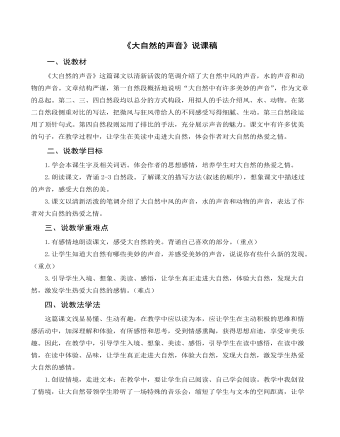
部编人教版三年级上册《大自然的声音》说课稿
四、说教法学法这篇课文浅显易懂、生动有趣,在教学中应以读为本,应让学生在主动积极的思维和情感活动中,加深理解和体验,有所感悟和思考,受到情感熏陶,获得思想启迪,享受审美乐趣。因此,在教学中,引导学生入境、想象、美读、感悟,引导学生在读中感悟,在读中激情,在读中体验、品味,让学生真正走进大自然,体验大自然,发现大自然,激发学生热爱大自然的感情。 1.创设情境,走进文本:在教学中,要让学生自己阅读、自己学会阅读。教学中我创设了情境,让大自然带领学生聆听了一场特殊的音乐会,缩短了学生与文本的空间距离,让学生置身于自然之中,俨然是大自然中的一员,在情境中感知,体会到大自然声音的美妙,与文本产生了共鸣,激发了学生的学习兴趣,让学生成为学习的主人。 2.美读感悟,放飞想象:在教学中始终以“大自然中这些声音真是太美妙了”贯串始终,重点指导学生美读课文,抓住描写声音的词,边读边思考,大胆的展开想象,有感情地读,配乐读,自由读,分组读,师生合读,全班齐读,在读中生成自己独特的感受、体验和理解,感受风声的美妙,水声的有趣,动物声的快乐,同时培养学生的语感。 3.拓展延伸,提高能力:布置学生课后在大自然找一些新发现,拓展学生的学习空间,扩大视野,增长知识。让学生在课内外的学习中提高语文素养。
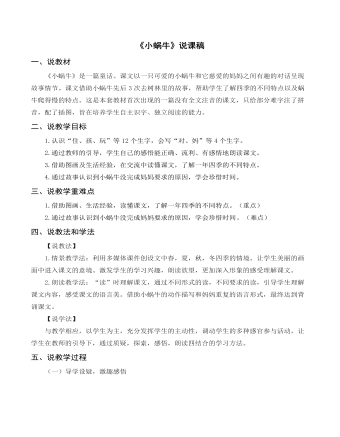
部编人教版一年级上册《小蜗牛》说课稿
(二)合作探究,解疑释困。1.你能用什么办法记住“蜗”这个字吗?? 2.结合插图认识“芽、草、莓、蘑、菇”五个生字。?【设计意图】低年级学生形象思维占主导地位,用图片对所学的汉字进行理解和记忆,分散了学生识字的难度,完成了课后练习二。? 33.同桌互读课文,要求:读准字音,读通句子。如果他都读对了,你就夸夸他;如果他读错了,你就帮帮他。?4.认读句子和词语。?(1)认读句子。?课件出示:①小蜗牛爬呀,爬呀,好久才爬回来。②“孩子,到小树林里去玩吧,小树发芽了。”③“妈妈,草莓没有了,地上长着蘑菇,树叶全变黄了。”?(2)认读词语:住在?好久?蜗牛?玩吧?爬呀爬? 5.再读课文,一边读一边找,小蜗牛和妈妈一共进行了几次对话?你是怎么找到的?引导学生认识冒号、引号,并简单了解用法。? 6.它们说了什么呢?蜗牛妈妈的话用“?_____”画出来;小蜗牛的话用“~~?”画出来。7.他们的第一次对话在第几自然段?这次对话讲述的是什么时候?蜗牛妈妈让小蜗牛去哪干什么?? 8.看第一幅图,观察小蜗牛和蜗牛妈妈在一起时的表情和姿态,想象一下,这对母子感情怎么样?蜗牛妈妈会怎样对小蜗牛说话呢?? 指名朗读,注意声音要轻柔,语速可以稍慢,读出妈妈对小蜗牛的疼爱。
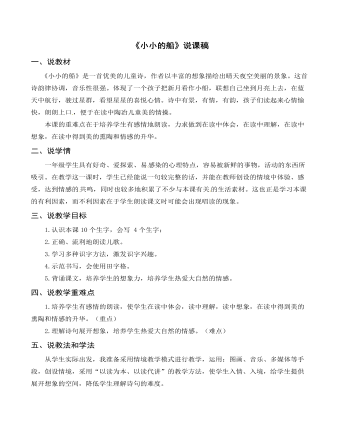
部编人教版一年级上册《小小的船》说课稿
(2)综合运用图画、语言、音乐,再创情境。(教师描述)如果现在是夜晚,我们一起坐在院子里,抬头看天空,蓝天上有星星,有月亮。这弯弯的月亮,它多像一艘小船呀!(播放背景音乐)现在请大家听着音乐 轻轻摆,慢慢地闭上眼睛。想着,想着,你是不是坐在月亮上了?是不是飞上蓝天了?(此时学生会情不自禁说自己已经飞上蓝天,已经坐在月亮上了。)当学生睁开眼睛,(师播放课件)哈,小朋 友现在我们已经飞上天了,已经坐在小船里了,让我们在月亮上愉快地唱起《小小的船》(播放儿童歌曲《小小的船》),伴随着歌声的响起,学生就会进入美妙的境界。教师随即出示句式:我看见了____________________________________。引导学 生说出:宇宙飞船上天,航天飞机登上月球等。接着再用“蓝蓝的天”进行说话训练。例如蓝蓝的天上有什么?我在蓝蓝的天上干什么?不难看出,在理解重点句子时,根据创设的情境,让学生充分展开想象的翅膀,学生往往为此而兴奋不已,学生情绪为之高涨,进入一个高潮。此举极大地丰富了课文内容,学生的学就乐在其中,悟也在其中。

